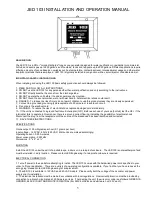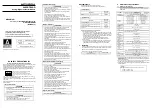
When an
INITiate
command is executed, the driver checks several
interrelated settings programmed in the previous steps. If there are conflicts
in these settings an error message is placed in the error queue (read with the
SYSTem:ERRor?
command). Some examples:
•
If
TRIGger:SOURce
is not
TIMer
or
IMMediate
with
INITiate:CONTinuous ON
, then
ARM:SOURce
must be
IMMediate
.
•
Have programmable SCP gain or Current Source SCP settings
changed since the
*CAL?
command was executed?
Step 10. Retrieving Data
Each reading made during a scan is (by default) stored in two places:
•
The 64-channel Current Value Table (CVT). As the name implies,
the CVT contains the most current value read for each channel.
•
The 65,024 reading FIFO buffer. The FIFO allows the A/D to
maintain its high reading rate while your program transfers readings
from this buffer.
Readings can be continuously retrieved while the instrument is scanning.
Accessing the CVT
A single command provides access to the channel readings in the Current
Value Table:
[SENse:]DATA:CVTable? (@<
ch_list
>)
•
The
<
ch_list
>
parameter specifies which channel value(s) to retrieve
from the CVT.
Note
After
*RST
/power-on, each channel location in the CVT contains the
IEEE-754 value “ Not-a Number” (NaN). Channel readings which are a
positive overvoltage return
IEEE
+INF
and negative overvoltage return
IEEE
-INF
. Refer to the
FORMat[:DATA
] command in Chapter 5 for the
NaN, +INF, and -INF values for each data format.
To access the latest reading from each of the instrument’s 64 channels:
SENS:DATA:CVT? (@100:163)
Completes when 64 readings
have been accepted by an input
statement.
Execute program input statement here.
Must input 64 readings.
To reset the CVT (and set all values to NaN), send the command
[SENSe:]DATA:CVTable:RESet
.
90 Using the HP E1313/E1413
Chapter 3
Artisan Technology Group - Quality Instrumentation ... Guaranteed | (888) 88-SOURCE | www.artisantg.com
















































